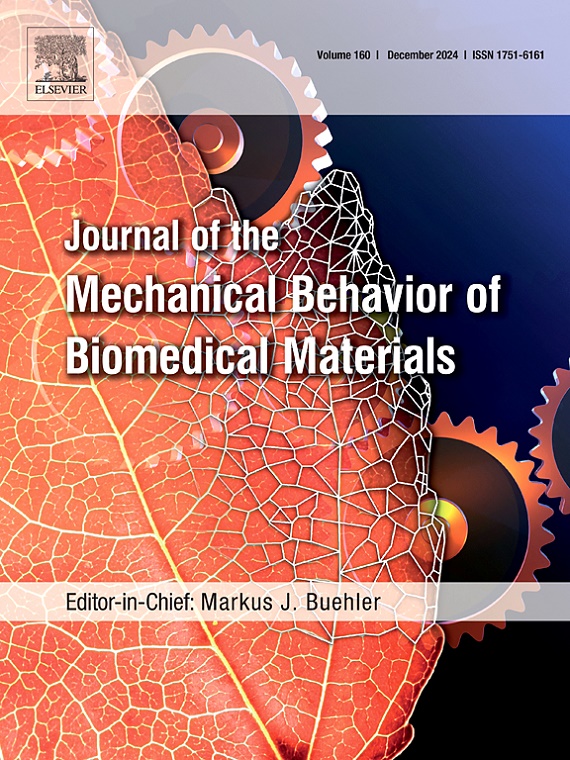三尖瓣边缘到边缘修复模拟对环空边界条件高度敏感。
IF 3.3
2区 医学
Q2 ENGINEERING, BIOMEDICAL
Journal of the Mechanical Behavior of Biomedical Materials
Pub Date : 2024-12-22
DOI:10.1016/j.jmbbm.2024.106879
引用次数: 0
摘要
经导管边缘到边缘修复(TEER)模拟可以深入了解这种新型治疗技术,并有助于优化其使用。然而,由于TEER模拟的历史相对较短和技术复杂性,一些重要问题仍未得到解答。例如,在这些模拟中如何处理环形边界条件没有达成共识。在这篇简短的通信中,我们使用人体三尖瓣的高保真有限元模型测试了这种模拟对环形边界条件选择的敏感性。其中,我们将环嵌入弹性弹簧中以模拟瓣周心肌的顺应性。接下来,我们参数化地改变了弹簧刚度,并探讨了对阀功能的两个关键指标的影响:适应面积和叶应力。此外,我们将结果与固定环空的模拟结果进行了比较。我们发现,如临床观察到的那样,一个顺从的环边界条件导致teer诱导的“环成形术效应”,即环重构。此外,更软的弹簧导致更大的适应面积和更小的小叶应力。另一方面,固定环空边界条件导致不切实际的高应力,没有“环成形效应”。此外,我们发现边界条件的影响取决于夹片位置。我们在这个案例研究中的发现强调了环形边界条件在三尖瓣TEER模拟中的重要性。因此,我们建议在选择环形边界条件时要小心,并且使用固定边界的模拟结果应谨慎解释。本文章由计算机程序翻译,如有差异,请以英文原文为准。

Tricuspid valve edge-to-edge repair simulations are highly sensitive to annular boundary conditions
Transcatheter edge-to-edge repair (TEER) simulations may provide insight into this novel therapeutic technology and help optimize its use. However, because of the relatively short history and technical complexity of TEER simulations, important questions remain unanswered. For example, there is no consensus on how to handle the annular boundary conditions in these simulations. In this short communication, we tested the sensitivity of such simulations to the choice of annular boundary conditions using a high-fidelity finite element model of a human tricuspid valve. Therein, we embedded the annulus among elastic springs to simulate the compliance of the perivalvular myocardium. Next, we varied the spring stiffness parametrically and explored the impact on two key measures of valve function: coaptation area and leaflet stress. Additionally, we compared our results to simulations with a pinned annulus. We found that a compliant annular boundary condition led to a TEER-induced “annuloplasty effect,” i.e., annular remodeling, as observed clinically. Moreover, softer springs led to a larger coaptation area and smaller leaflet stresses. On the other hand, pinned annular boundary conditions led to unrealistically high stresses and no “annuloplasty effect.” Furthermore, we found that the impact of the boundary conditions depended on the clip position. Our findings in this case study emphasize the importance of the annular boundary condition in tricuspid TEER simulations. Thus, we recommend that care be taken when choosing annular boundary conditions and that results from simulations using pinned boundaries should be interpreted with caution.
求助全文
通过发布文献求助,成功后即可免费获取论文全文。
去求助
来源期刊

Journal of the Mechanical Behavior of Biomedical Materials
工程技术-材料科学:生物材料
CiteScore
7.20
自引率
7.70%
发文量
505
审稿时长
46 days
期刊介绍:
The Journal of the Mechanical Behavior of Biomedical Materials is concerned with the mechanical deformation, damage and failure under applied forces, of biological material (at the tissue, cellular and molecular levels) and of biomaterials, i.e. those materials which are designed to mimic or replace biological materials.
The primary focus of the journal is the synthesis of materials science, biology, and medical and dental science. Reports of fundamental scientific investigations are welcome, as are articles concerned with the practical application of materials in medical devices. Both experimental and theoretical work is of interest; theoretical papers will normally include comparison of predictions with experimental data, though we recognize that this may not always be appropriate. The journal also publishes technical notes concerned with emerging experimental or theoretical techniques, letters to the editor and, by invitation, review articles and papers describing existing techniques for the benefit of an interdisciplinary readership.
 求助内容:
求助内容: 应助结果提醒方式:
应助结果提醒方式:


